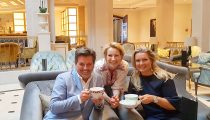Who: Claudia and Thomas Anders Where: Koblenz, Germany Meet me…
Jörg Woltmann: “Taste is also connected with haptics.”
Who: Jörg Woltmann, owner of KPM Berlin
Where: Berlin

Jörg Woltmann prefers to enjoy his tea from his Kurland cup “Royal Noir” with gilded relief edge
Thirteen years ago, he bought KPM, the Royal Porcelain Manufactory in Berlin – and that before its insolvency: Jörg Woltmann, Berlin’s old hand, banker, entrepreneur. A visionary who, contrary to all expert advice, bought the long-established Berlin company for 13.5 million euros, which today employs more than 200 people, around 120 in porcelain production alone. KPM is one of the world’s oldest luxury brands – founded in 1763 by Frederick the Great, King of Prussia, it has since belonged to seven kings and emperors. Since 1872, the company has resided on the historic factory premises in Berlin-Charlottenburg, directly next to the Tiergarten, where Jörg Woltmann welcomes me in his elegant office furnished with English antiques. Tea is served between wood-clad walls and a portrait of “Old Fritz”. Of course, from KPM cups. A “Meet me for tea” interview about the love of porcelain and the preservation of a cultural asset.
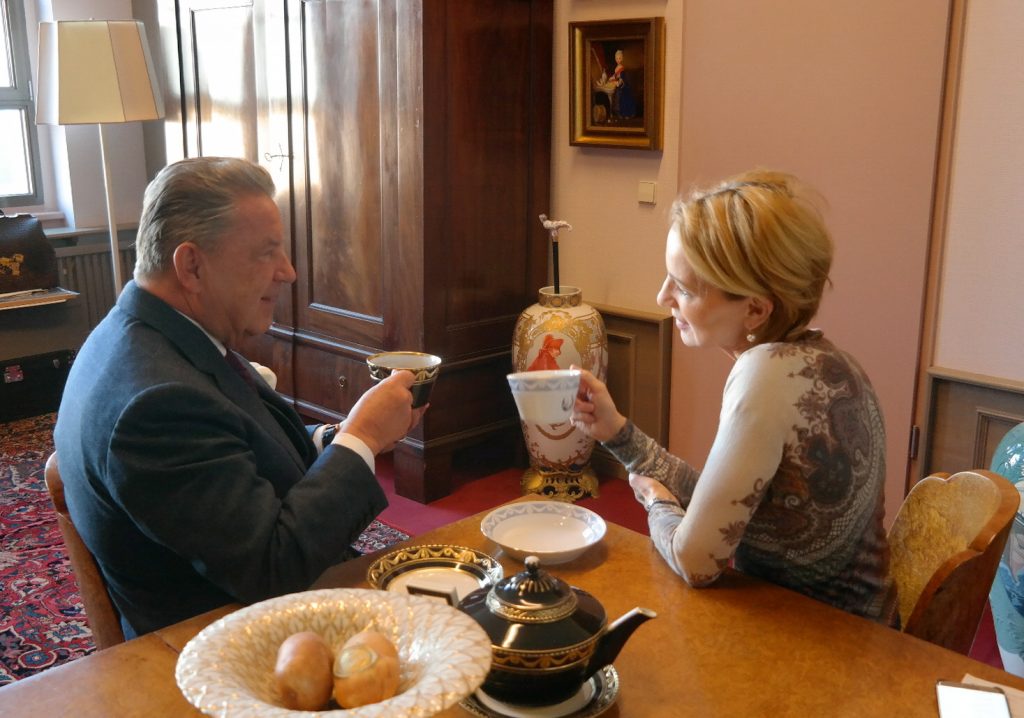
The shape of the cup dates from 1790 and is still one of the classics of the KPM range. In the “Royal Noir” version with gold edge, the cup costs 1,190 euros each. I drink from a coloured Kurland cup, a so-called decorated cup. For two years they have been dishwasher safe thanks to a special glaze developed by KPM
MyStylery: What was it like when you acquired KPM 13 years ago?
Jörg Woltmann: I can still remember exactly that the notary appointment lasted from 4 p.m. in the afternoon until 5 a.m. of the next day. Continuously. Many legal subtleties had to be taken into account. The only interruption was the pizza delivery boy.
MS: In retrospect, would you invest the purchase price and the follow-up costs again?
JW: I have never regretted having bought the KPM, although many things came differently than expected. In the end, it was like building a house where everything is more expensive than previously calculated.
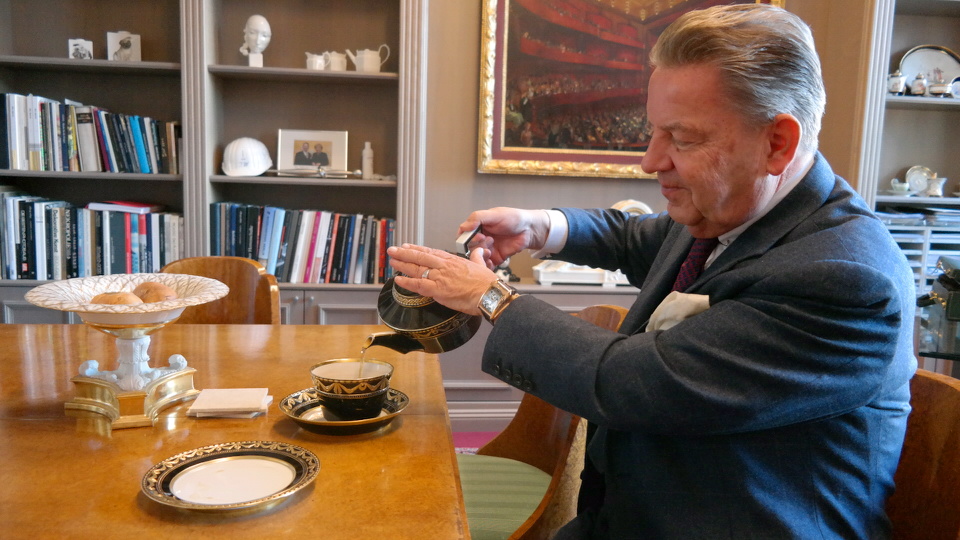
At the age of 32, Jörg Woltmann was the youngest banker in Germany. Today the entrepreneur is the owner of Allgemeine Beamtenbank (General Civil Servants’ Bank), hotelier and since 2006 owner of KPM Berlin
MS: KPM was on the verge of collapse. What went wrong back then?
JW: After the Second World War, the state of Berlin became the owner of the manufactory. First and foremost, efforts were made to preserve the cultural asset KPM for Berlin with state subsidies, instead of running the business in an entrepreneurial manner and promoting exports. KPM was subordinated to the Cultural Senate, which commissioned artists for the design. The only thing that disturbed them was the customer. Basically, it is difficult to make a porcelain manufactory profitable.
MS: What is the challenge?
JW: Table culture has changed a lot.
MS: Although young people nowadays spend more money on living and eating again, they save on what they have and buy their tableware from Ikea.
JW: Many lack the appreciation for the craft and the idea of how elaborate the production process of a single cup alone is. If you consider that 25 craftsmen work on a Kurland cup, that it takes 14 days and 29 steps to make it, and that it then undergoes ten quality controls, you should be respected. Today I still walk through the manufactory with great humility. What is done here is world class. I therefore hope that people will rediscover the sense of a stylishly set table, of sustainability and craftsmanship.
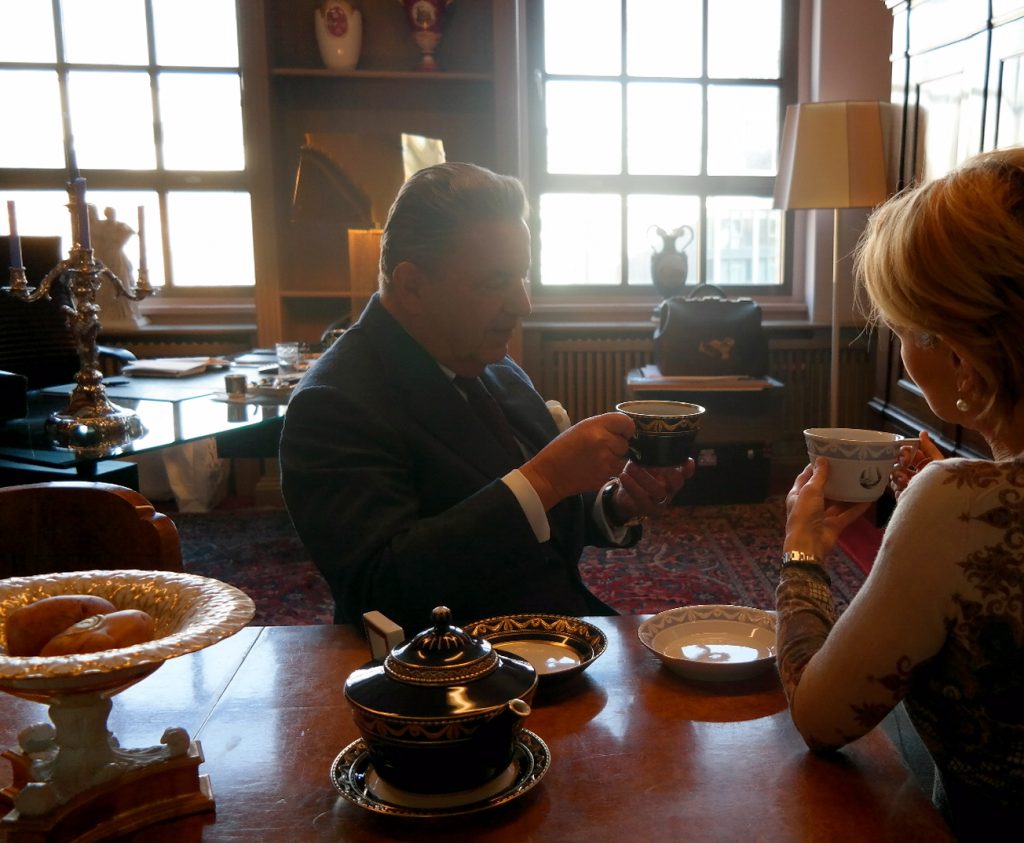
The son of a dressmaker has achieved his own success. “It took a little naivety to start my own bank at the age of thirty,” he says in retrospect. “I’m glad I had that naivety.”
MS: Today, many young people prefer to study handicraft. Does KPM have problems with recruiting young people?
JW: On the contrary. There are 15 to 20 applications for a porcelain painter, although the training takes three and a half years. After that, the porcelain painter needs another ten years of practical experience to be able to meet the high-quality standards. We are one of the few training companies in this field and proud of the fact that our apprentices always score top marks.
MS: Must a budding porcelain painter have talent for drawing and be able to paint “correctly”?
JW: Yes, the applicants must submit sketchbooks before they can prove their talent for this job over several days of selection. This profession is ultimately a vocation.
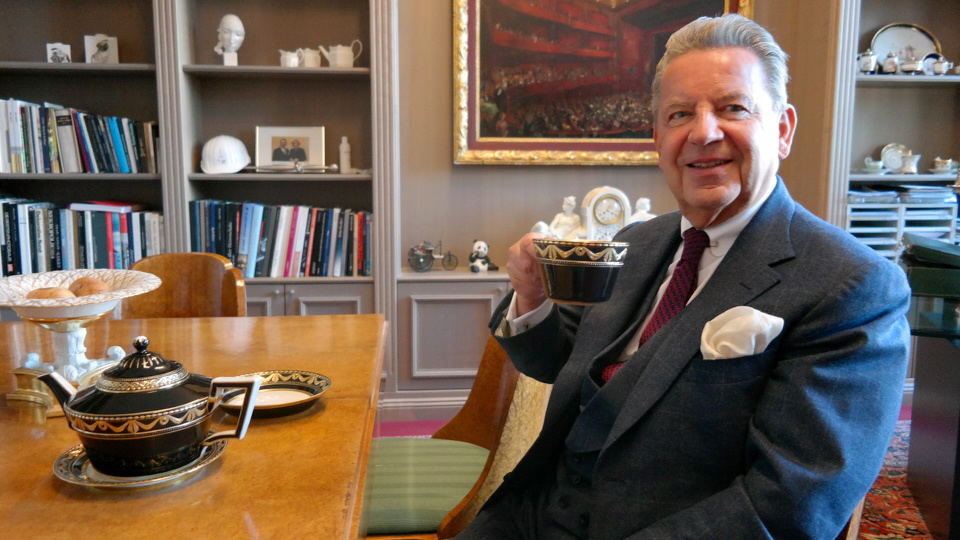
“I bought the manufactory when I was 59 – the right time for me. I didn’t have to prove anything anymore,” says Jörg Woltmann. “When I was almost sixty years old, I had the knowledge and experience that I could face up to this task without getting upset.”
MS: The younger generation in particular buys almost everything online today. How does KPM’s online trading work?
JW: We are very satisfied, although I had doubts at the beginning. I always thought a haptic product had to be touched before making a purchase decision. But quality and reputation speak for themselves. In the magazine “Bunte”, the mention of the must-have of the week is enough, and the number of clicks is already going up. We have developed products especially for the target group of young consumers, such as the “LAB” series, retro coffee filters and mortars. Instead of drinking from a paper cup, you now drink your coffee-to-go from the “To Go” cup from KPM.
MS: Is KPM profitable by now?
JW: If I didn’t invest so much, I could be in the black. Every year I spend between 500,000 and 800,000 euros on preserving the cultural heritage alone. This includes the archive with over 250 years of German cultural history. Drawings and forms that the architect Karl Friedrich Schinkel and the sculptor Johann Gottfried Schadow once held in their hands have to be extensively revised today. That’s why I established a foundation three years ago, into which the cultural assets are gradually being transferred. The production remains unaffected by this.
MS: You could sleep more peacefully if you hadn’t tied this task to your leg.
JW: Probably. But I bought one of the last luxury brands still available in the world. And which entrepreneur gets the chance to acquire a cultural asset? I prefer my commitment here to running around on the golf course. (laughs.) I come from the dax-controlled world of banks. Through KPM, a completely different circle of people from art and culture has opened up for me, which I find enriching.
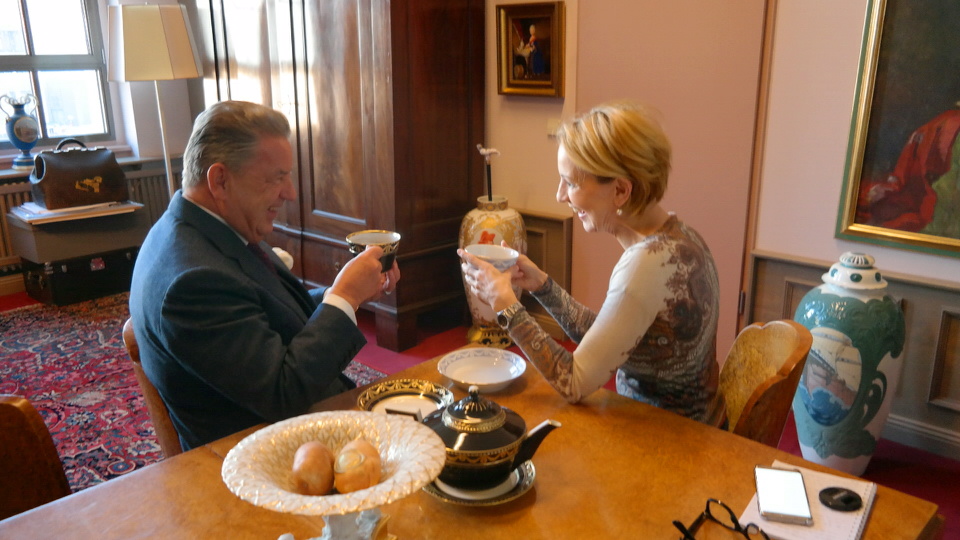
Besides porcelain, Jörg Woltmann cultivates his second passion: cars. Among them is his favourite car, a Mercedes-Benz 300 SL Roadster from 1960, black with dark green interior. “It has never been restored before, everything is original, including the paintwork,” enthuses Jörg Woltmann. “Unfortunately, these are today more standing vehicles than vehicles.”
MS: As a post-war child, you grew up beyond luxury. Your mother brought it up from a tailor to a successful entrepreneur. Remarkable.
JW: I had a very happy childhood in which I grew up with great love and affection. Our house in Berlin’s district Lichterfelde also accommodated the production, so that we were always close to our mother. I remember how for the first time I didn’t have to wear my brother’s clothes, but got something of my own to wear: A pair of velvet trousers. That was very special, like the fine tableware, which was only served on Sundays.
MS: Did that shape your sense for porcelain?
JW: Absolutely. When I was 28, I sold my first company and bought a porcelain service from the proceeds: Kurland from KPM, which we still use at home. Daily and not just for special occasions.
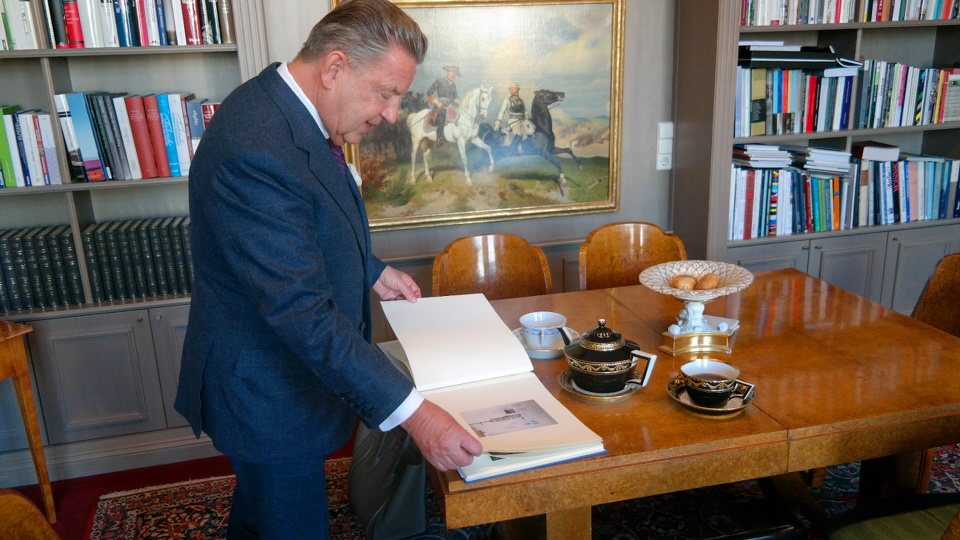
“The only time I was permanently employed was during the three years of my apprenticeship at Bankhaus Hermann Lampe. After that I always worked independently and created things.”
MS: KPM in the morning, banking in the afternoon. How long do you want to face the daily struggle?
JW: My wife knows that I’m going to work till I fall down. (laughs). I’m taking it slower today and I’m also taking some vacations. We enjoy dinner together, then I relax with a swim or in the sauna. I have largely retired from active day-to-day business. But I represent the company to the outside world and network. Each day I have four invitations, four of which I receive each week.
MS: You are also an enthusiastic tea drinker…
JW: Yes, the morning begins with a freshly squeezed orange juice and a cup of tea. Then I have to eat muesli. (laughs). By the way, I get my tea from Taiwan business friends who give me green or black teas, which are not available here. Tea is my constant companion, even in the office there is always a pot in front of me. By the way, I always drink from a Kurland office cup. The tea simply tastes best from it. Taste is also connected with haptics.
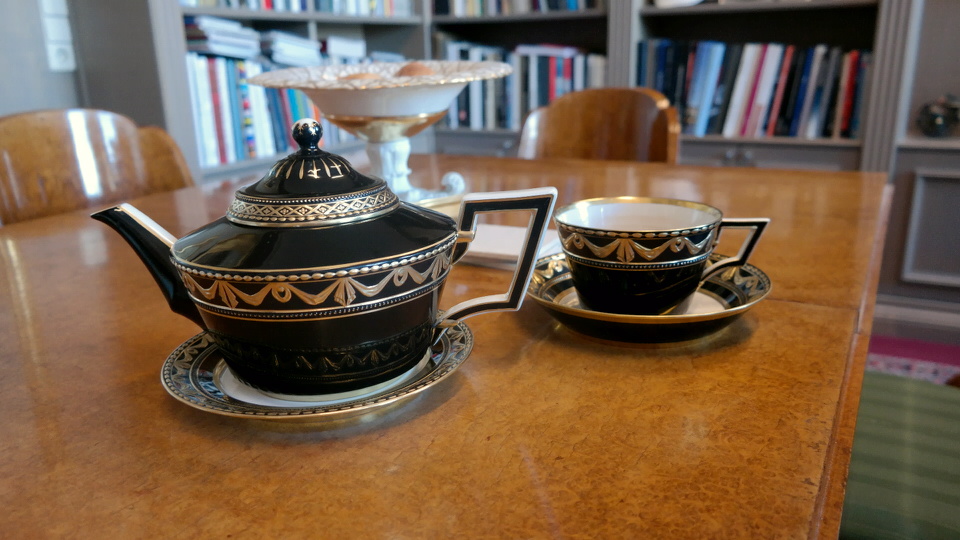
International guests visiting the Federal President of Germany in Schloss Bellevue, of course, dine from tableware by KPM Berlin
MS: What happens next with the KPM?
JW: As far as personnel is concerned, KPM is well positioned. I have great confidence in my employees, many of whom are better than me. A large market today is Asia, where there is a strong demand for high-quality painted porcelain. That’s why I’m confident that the company will earn a lot of money again. KPM is the oldest manufacturing company in Berlin and I would like to preserve the manufactory for Germany.
MS: For your patriotism, the political leaders here would have to shower you with praise and recognition all the time.
JW: They do. I have already received the Federal Cross of Merit. Well, that doesn’t cost any money. (laughs) Nevertheless, I find that a cultural asset belongs in principle to the state. It just has to be managed correctly.
MS: Does it annoy you that the Berlin Senate has acted so carelessly here?
JW: Yes, from my personal point of view it does. On the other hand, I also say that – if the state is not in a position – the citizen is asked to get involved. You can’t always just hold out your hand. You also have to give something back. BvH
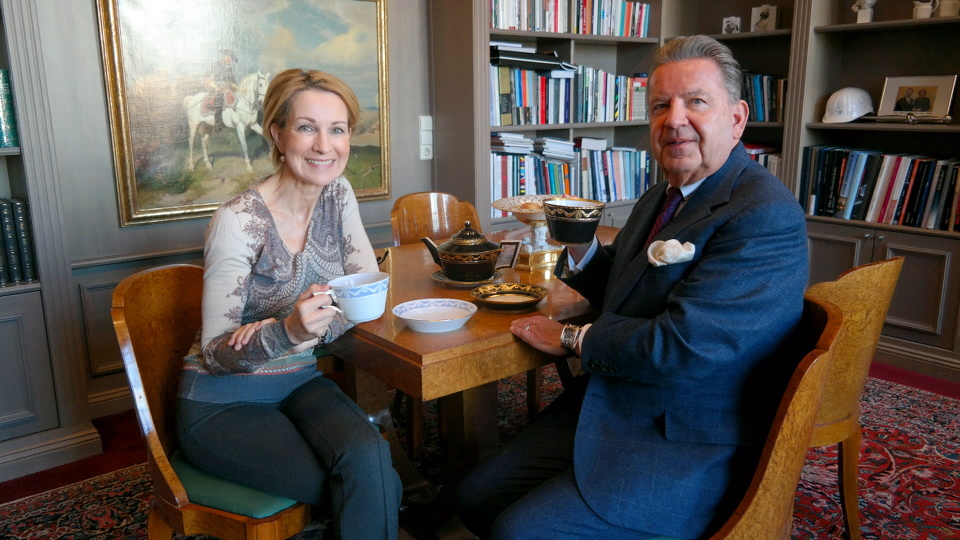
Jörg Woltmann calls Prussian virtues the cornerstones of his success: diligence and sincerity. And he is proud that he and his family have always kept their feet on the ground
Contact
More “Meet me for Tea”-interviews you’ll find here.

